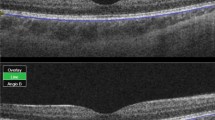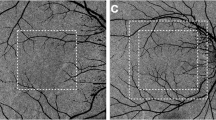Abstract
Purpose
To investigate the features of the choriocapillaris using four different optical coherence tomography angiography (OCTA) devices.
Methods
OCTA images of the choriocapillaris from consecutive healthy subjects were obtained with four different OCTA devices (Zeiss PLEX Elite, Topcon DRI OCT-1 Atlantis, Zeiss AngioPlex, and Heidelberg Spectralis OCTA). The 3 × 3 mm OCTA images were processed with ImageJ. The mean vascular density and mean flow void area of the choriocapillaris were compared among devices. Flow voids were analyzed with two different imaging adjustment methods, auto-local threshold with the Phansalkar method and a method using a device-specific threshold value.
Results
The mean vascular density of the choriocapillaris differed among the four devices (all P < 0.001). The mean flow void area as measured with the auto-local threshold method also differed among devices (P < 0.001) and was not correlated among devices (all P > 0.05). Results for mean flow void area measured with a device-specific threshold value using the Plex-Elite and DRI OCT-1 Atlantis were correlated (ß = 2.271, P < 0.001), but there were no correlations among other devices (P > 0.05). For the Plex-Elite and DRI OCT-1 Atlantis, the mean flow void area was positively correlated between the two image adjustment methods (all P < 0.05).
Conclusions
Vascular densities and flow void areas of the choriocapillaris varied according to the device used and the image adjustment method. The characteristics of different devices and the image adjustment method should be considered for analysis of the choriocapillaris.




Similar content being viewed by others
References
Ferrara D, Waheed NK, Duker JS (2016) Investigating the choriocapillaris and choroidal vasculature with new optical coherence tomography technologies. Prog Retin Eye Res 52:130–155. https://doi.org/10.1016/j.preteyeres.2015.10.002
Hayreh SS (1974) Vascular pattern of the choriocapillaris. Exp Eye Res 19:101–104
Hayreh SS (1974) The choriocapillaris. Albrecht Von Graefes Arch Klin Exp Ophthalmol 192:165–179
Spaide RF, Klancnik JM Jr, Cooney MJ (2015) Retinal vascular layers imaged by fluorescein angiography and optical coherence tomography angiography. JAMA Ophthalmol 133:45–50. https://doi.org/10.1001/jamaophthalmol.2014.3616
Matsunaga D, Yi J, Puliafito CA, Kashani AH (2014) OCT angiography in healthy human subjects. Ophthalmic Surg Lasers Imaging Retina 45:510–515. https://doi.org/10.3928/23258160-20141118-04
Gao SS, Jia Y, Zhang M, Su JP et al (2016) Optical coherence tomography angiography. Invest Ophthalmol Vis Sci 57:27–36. https://doi.org/10.1167/iovs.15-19043
Spaide RF (2016) Choriocapillaris flow features follow a power law distribution: implications for characterization and mechanisms of disease progression. Am J Ophthalmol 170:58–67. https://doi.org/10.1016/j.ajo.2016.07.023
Spaide RF, Fujimoto JG, Waheed NK (2015) Image artifacts in optical coherence tomography angiography. Retina 35:2163–2180. https://doi.org/10.1097/IAE.0000000000000765
Corvi F, Pellegrini M, Erba S, Cozzi M, Staurenghi G, Giani A (2018) Reproducibility of vessel density, fractal dimension, and foveal avascular zone using 7 different optical coherence tomography angiography devices. Am J Ophthalmol 186:25–31. https://doi.org/10.1016/j.ajo.2017.11.011
Lauermann JL, Eter N, Alten F (2018) Optical coherence tomography angiography offers new insights into choriocapillaris perfusion. Ophthalmologica 239:74–84. https://doi.org/10.1159/000485261
Coscas G, Lupidi M, Coscas F (2016) Heidelberg spectralis optical coherence tomography angiography: technical aspects. Dev Ophthalmol 56:1–5. https://doi.org/10.1159/000442768
Rosenfeld PJ, Durbin MK, Roisman L et al (2016) ZEISS angioplex spectral domain optical coherence tomography angiography: technical aspects. Dev Ophthalmol 56:18–29. https://doi.org/10.1159/000442773
Stanga PE, Tsamis E, Papayannis A, Stringa F, Cole T, Jalil A (2016) Swept-source optical coherence tomography angio (Topcon Corp, Japan): technology review. Dev Ophthalmol 56:13–17. https://doi.org/10.1159/000442771
Rabiolo A, Gelormini F, Marchese A et al (2018) Macular perfusion parameters in different angiocube sizes: Does the size matter in quantitative optical coherence tomography angiography? Invest Ophthalmol Vis Sci 59:231–237. https://doi.org/10.1167/iovs.17-22359
Spaide RF (2017) Choriocapillaris signal voids in maternally inherited diabetes and deafness and in pseudoxanthoma elasticum. Retina 37:2008–2014. https://doi.org/10.1097/IAE.0000000000001497
Zheng F, Zhang Q, Shi Y et al (2019) Age-dependent changes in the macular choriocapillaris of normal eyes imaged with swept-source optical coherence tomography angiography. Am J Ophthalmol 200:110–122. https://doi.org/10.1016/j.ajo.2018.12.025
Lauermann JL, Heiduschka P, Nelis P et al (2017) Comparison of choriocapillaris flow measurements between two optical coherence tomography angiography devices. Ophthalmologica 237:238–246. https://doi.org/10.1159/000464355
Munk MR, Giannakaki-Zimmermann H, Berger L et al (2017) OCT-angiography: a qualitative and quantitative comparison of 4 OCT-A devices. PLoS ONE 12:e0177059. https://doi.org/10.1371/journal.pone.0177059
Zhang Q, Zheng F, Motulsky EH et al (2018) A novel strategy for quantifying choriocapillaris flow voids using swept-source OCT angiography. Invest Ophthalmol Vis Sci 59:203–211. https://doi.org/10.1167/iovs.17-22953
Rochepeau C, Kodjikian L, Garcia MA et al (2018) Optical coherence tomography angiography quantitative assessment of choriocapillaris blood flow in central serous chorioretinopathy. Am J Ophthalmol 194:26–34. https://doi.org/10.1016/j.ajo.2018.07.004
Copete S, Flores-Moreno I, Montero JA, Duker JS, Ruiz-Moreno JM (2014) Direct comparison of spectral-domain and swept-source OCT in the measurement of choroidal thickness in normal eyes. Br J Ophthalmol 98:334–338. https://doi.org/10.1136/bjophthalmol-2013-303904
Miller AR, Roisman L, Zhang Q et al (2017) Comparison between spectral-domain and swept-source optical coherence tomography angiographic imaging of choroidal neovascularization. Invest Ophthalmol Vis Sci 58:1499–1505. https://doi.org/10.1167/iovs.16-20969
Novais EA, Adhi M, Moult EM et al (2016) Choroidal neovascularization analyzed on ultrahigh-speed swept-source optical coherence tomography angiography compared to spectral-domain optical coherence tomography angiography. Am J Ophthalmol 164:80–88. https://doi.org/10.1016/j.ajo.2016.01.011
Zhang Q, Chen CL, Chu Z et al (2017) Automated quantitation of choroidal neovascularization: a comparison study between spectral-domain and swept-source OCT angiograms. Invest Ophthalmol Vis Sci 58:1506–1513. https://doi.org/10.1167/iovs.16-20977
Unterhuber A, Povazay B, Hermann B et al (2005) In vivo retinal optical coherence tomography at 1040 nm—enhanced penetration into the choroid. Opt Express 2(13):3252–3258
Choi W, Waheed NK, Moult EM et al (2017) Ultrahigh speed swept source optical coherence tomography angiography of retinal and choriocapillaris alterations in diabetic patients with and without retinopathy. Retina 37:11–21. https://doi.org/10.1097/IAE.0000000000001250
Choi W, Moult EM, Waheed NK et al (2015) Ultrahigh-speed, swept-source optical coherence tomography angiography in nonexudative age-related macular degeneration with geographic atrophy. Ophthalmology 122:2532–2544. https://doi.org/10.1016/j.ophtha.2015.08.029
Chu Z, Zhou H, Cheng Y et al (2018) Improving visualization and quantitative assessment of choriocapillaris with swept source OCTA through registration and averaging applicable to clinical systems. Sci Rep 14(8):16826. https://doi.org/10.1038/s41598-018-34826-5
Borrelli E, Sarraf D, Freund KB, Sadda SR (2018) OCT angiography and evaluation of the choroid and choroidal vascular disorders. Prog Retin Eye Res 67:30–55. https://doi.org/10.1016/j.preteyeres.2018.07.002
Lovasik JV, Kergoat H, Riva CE, Petrig BL, Geiser M (2003) Choroidal blood flow during exercise-induced changes in the ocular perfusion pressure. Invest Ophthalmol Vis Sci 44:2126–2132
Sarwar S, Hassan M, Soliman MK et al (2018) Diurnal variation of choriocapillaris vessel flow density in normal subjects measured using optical coherence tomography angiography. Int J Retina Vitr. 4:37. https://doi.org/10.1186/s40942-018-0140-0(eCollection 2018)
Funding
This study was funded by the National Research Foundation of Korea (Ministry of Science, ICT and Future Planning of the Korean government) (NRF-2017R1C1B5076520).
Author information
Authors and Affiliations
Corresponding author
Ethics declarations
Conflict of interest
Jaeryung Oh is a consultant of Topcon corporation. Other authors declare that they have no conflict of interest.
Ethical approval
All procedures performed in studies involving human participants were in accordance with the ethical standards of the institutional and/or national research committee and with the 1964 Helsinki declaration and its later amendments or comparable ethical standards.
Informed consent
Informed consent was obtained from all individual participants included in the study.
Additional information
Publisher's Note
Springer Nature remains neutral with regard to jurisdictional claims in published maps and institutional affiliations.
Electronic supplementary material
Below is the link to the electronic supplementary material.
Rights and permissions
About this article
Cite this article
Yun, C., Nam, K.T., Park, S. et al. Features of the choriocapillaris on four different optical coherence tomography angiography devices. Int Ophthalmol 40, 325–333 (2020). https://doi.org/10.1007/s10792-019-01182-w
Received:
Accepted:
Published:
Issue Date:
DOI: https://doi.org/10.1007/s10792-019-01182-w




